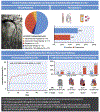Left Main Spontaneous Coronary Artery Dissection: Clinical Features, Management, and Outcomes
- PMID: 40208153
- PMCID: PMC12290918
- DOI: 10.1016/j.jcin.2025.01.427
Left Main Spontaneous Coronary Artery Dissection: Clinical Features, Management, and Outcomes
Abstract
Background: Spontaneous coronary artery dissection (SCAD) is an uncommon cause of acute myocardial infarction (MI) and is associated with substantial adverse events. SCAD involving the left main coronary artery (LM) is a rare but potentially life-threatening condition. Currently, minimal data on LM SCAD have been reported.
Objectives: The aim of this study was to investigate clinical features, contemporary management, and clinical outcomes of patients with LM SCAD.
Methods: A systematic review and pooled analysis of published case reports was conducted using "left main" and "dissection" as keywords. The authors screened 1,106 papers in MEDLINE and Embase published between 1990 and 2023.
Results: The final analysis included 132 patients (mean age 40 ± 11 years, 80% women) diagnosed with LM SCAD. Remarkably, 36% of cases occurred during pregnancy, and 95% presented with acute coronary syndrome, 22% with cardiogenic shock, and 8% with ventricular arrhythmias. At 120-day median follow-up, all-cause death occurred in 9%, left ventricular assist device implantation or heart transplantation in 4%, recurrent MI in 13%, and urgent myocardial revascularization (MR) in 21%. Compared with conservative management, early revascularization by percutaneous coronary intervention or coronary artery bypass grafting significantly reduced the composite endpoint of all-cause death, left ventricular assist device implantation or heart transplantation, recurrent MI, and urgent MR (adjusted HR: 0.37; 95% CI: 0.20-0.69; P < 0.001).
Conclusions: LM SCAD carried significant acute morbidity and mortality. Early revascularization (percutaneous coronary intervention or coronary artery bypass graft) was associated with a lower incidence of early adverse outcomes compared with conservative management, driven largely by reduction in recurrent MI and urgent MR. These hypothesis-generating data should be confirmed in future prospective registries and clinical trials.
Keywords: acute coronary syndrome(s); cardiogenic shock; ischemic heart disease; myocardial infarction; spontaneous coronary artery dissection.
Copyright © 2025 American College of Cardiology Foundation. Published by Elsevier Inc. All rights reserved.
Conflict of interest statement
Funding Support and Author Disclosures Dr Beneduce has received speaker fees from Abiomed, Boston Scientific, and Medtronic, all outside the submitted work. Dr Baldetti has received speaker fees from Abiomed, outside the submitted work. Dr Pagnesi has received personal fees from Abbott Laboratories, AstraZeneca, Boehringer Ingelheim, Novartis, Roche Diagnostics, and Vifor Pharma, all outside the submitted work. Dr Tweet is supported by National Heart, Lung, and Blood Institute award K23HL155506. All other authors have reported that they have no relationships relevant to the contents of this paper to disclose.
Figures


References
-
- Saw J, Mancini GBJ, Humphries KH. Contemporary review on spontaneous coronary artery dissection. J Am Coll Cardiol. 2016;68:297–312. - PubMed
-
- Tweet MS, Hayes SN, Pitta SR, et al. Clinical features, management, and prognosis of spontaneous coronary artery dissection. Circulation. 2012;126:579–588. - PubMed
-
- Nishiguchi T, Tanaka A, Ozaki Y, et al. Prevalence of spontaneous coronary artery dissection in patients with acute coronary syndrome. Eur Heart J Acute Cardiovasc Care. 2016;5:263–270. - PubMed
-
- Nakashima T, Noguchi T, Haruta S, et al. Prognostic impact of spontaneous coronary artery dissection in young female patients with acute myocardial infarction: a report from the Angina Pectoris–Myocardial Infarction Multicenter Investigators in Japan. Int J Cardiol. 2016;207:341–348. - PubMed
Publication types
MeSH terms
Supplementary concepts
Grants and funding
LinkOut - more resources
Full Text Sources
Medical

